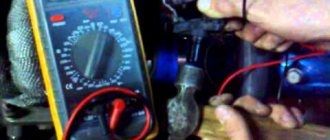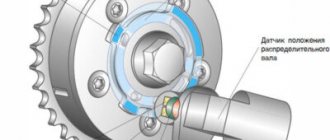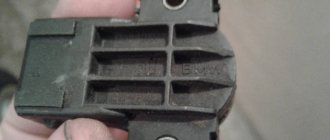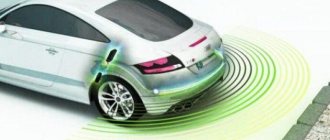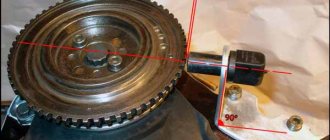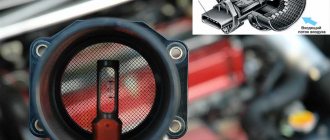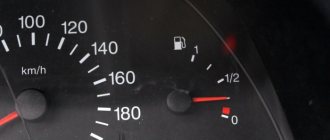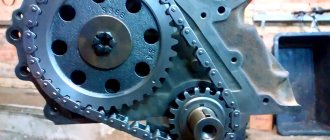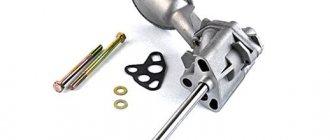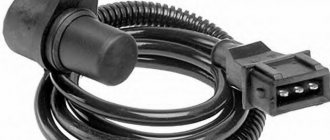Every car must be equipped with a working speed sensor (DS). This device allows you to accurately determine the speed of a vehicle and display information about it on the speedometer. Operating a car with a non-working DS is not allowed, as this can lead to an emergency on the road. How to check the speed sensor and replace the device yourself - read about it below.
Description of DS
As we have already said, the main purpose of the speedometer drive sensor is to accurately determine the speed of the vehicle. Thanks to this device, the model can always know at what speed his car is moving. As for the varieties, DS can be of the contact or non-contact type. Today, most of our compatriots prefer contactless options. Contact DS, despite all the advantages, have one significant drawback - they are prone to contamination, which in turn will lead to inaccuracy of the displayed readings.
Design and principle of operation
Structurally, according to the diagram, this part consists of:
- speedometer drive;
- housings;
- as well as the controller itself with a connector for connecting to the on-board network.
As for the principle of operation, it is based on measuring the frequency level of signals from the controller, which is located on the gearbox housing or transfer case. At the output of the device, while driving, rectangular pulses are formed, the minimum value of which should be at least 1 volt, and the maximum value should be at least 5 volts.
According to international standards, the controller must generate about 6 thousand such pulses over one kilometer. The pulses themselves are subsequently converted into current, which is measured by a magnetoelectric device. It should be noted that the current value directly depends on the number of signals supplied per certain unit of time. That is, this value will be directly proportional to the speed of the vehicle.
In addition, thanks to the electronic circuit installed in the dashboard, the operation of the stepper motor is ensured by counting incoming signals. The latter is designed to rotate the counter reels, after which it displays the relevant information on a small screen, where the total and daily mileage of the car is shown. If we are talking about daily mileage, then this value can be reset to zero if necessary.
Symptoms of a problem
If the DS for some reason fails, this will lead to the control unit being unable to determine the speed of movement. However, this is not the only problem, since malfunctions in the performance of the power unit may also occur.
We suggest that you familiarize yourself in more detail with the signs of a malfunction, by which you can determine the failure of the DS:
- the speedometer on the dashboard has either stopped working altogether or displays incorrect readings;
- malfunctions appear in engine operation, in particular at idle speed;
- fuel consumption increased;
- engine performance has deteriorated, the power unit cannot reach the required speed;
- the engine may stop spontaneously while idling, in particular when the driver tries to press the clutch to change gear;
- if the car is equipped with an on-board computer, a Check indicator may appear on the dashboard;
- if the car is equipped with an electric power steering, this unit may also fail;
- in some cars, for example, Lada Kalina, failure of the diesel engine can also lead to increased sensitivity of the fuel level controller in the gas tank (the author of the video is the Autoelectrics HF channel).
As for the reasons, as a rule, they are caused by damage to the car's electrical wiring, so checking the functionality should begin with diagnosing the condition of the contacts and electrical circuits. Perhaps the problem lies in oxidized or dirty contacts, so they will need to be cleaned and treated with a lubricant, for example, Lithol. A broken wiring should be looked for first of all near the connection connector, since in this place the wires are bent and usually frayed.
Causes of malfunction of the speed sensor
The absence of speedometer readings does not mean failure of the device. Although, to buy a speed sensor for a “ten”, it is enough to spend a small amount, but it will be very disappointing that the fact of replacing the speed sensor will not give the desired effect. And the reasons may be the following:
- The presence of dirt, dust and oil smudges on the speed sensor, a video on replacing which can be found on the Internet. They form on the body of the product during vehicle operation. To prevent the product in this case, you just need to clean the device.
- Unstable contact of the product connector and broken wiring.
- Sometimes the defect is of a purely mechanical nature, which consists of banal defects in the cable of the instrument speed indicator - speedometer.
The following options are possible here:
1. Complicated uneven movement of a braided cable, which is caused by cable defects - burrs or ruptures of the metal strands of the cable. They can significantly affect the functionality of the sensor drive. 2. Increased cable speed.
Checking the device for serviceability:
- We hang the front wheel of the vehicle on a jack.
- We disconnect the wire contact from the product and connect a digital multimeter or similar device to it
- Making rotational movements with the hanging wheel at low speed, we measure the pulse flow signal from the connector. The functionality test begins with checking the grounding and power supply of the electrical circuit.
- We remove the device from its seat.
- We connect the device for measuring voltage to the output contacts.
- By turning the speed sensor drive, we measure its potential difference.
- The output should produce data in which, as the rotor speed increases, the frequency and voltage of the output power increases.
The functionality of the device is considered satisfactory if, during diagnostics, it shows the frequency and voltage parameters at the output contact. Otherwise, replacing the speed sensor of the VAZ “Ten” cannot be avoided.
Functionality check
There are several options for diagnosing DS.
The first way to check is with a multimeter:
- First you need to dismantle the DS.
- Then, using a tester, you should determine what each contact on the connector is responsible for; you need to find exactly the pulse one.
- After this, the positive probe of the tester must be connected to this contact, and the negative probe to the power unit or car body.
- Next, you should install a piece of tube on the controller axis and start rotating it at low speed. At the same time, monitor the controller readings - the higher the rotation speed of the DS tube, the higher the values on the tester display and the voltage parameter will be (the author of the video is the REMONTYCA channel).
Second method, without removing the controller:
- Using a jack, you will need to lift the front wheel of the car. Which one - right or left - does not matter.
- Then the tester should be connected to the DC wiring.
- After this, you begin to rotate the car wheel with your hands and monitor the readings on the tester display. If there are impulses, then this indicates that the DS is operating in normal mode.
If you don’t have a multimeter, you can diagnose the DC using a test light or any other 12-volt lamp.
The verification procedure is similar to the method described above:
- First, you need to disconnect the pulse cable from the DC.
- With the ignition on, using a tester, you need to find the positive and negative contacts.
- Then the front wheel of the car is raised on a jack.
- Next, the control must be connected to the signal wire. The wheel must be rotated - if at this moment the minus light on the control panel lights up, this indicates that the DS is working (the author of the video is the PivovarovNikolay channel).
As for a 12-volt light bulb, it must be connected to a battery, as well as a signal contact. If a working DS is used, the light source will blink. If the diagnostics showed that the DS is working, then it is necessary to check the functionality of its drive. To do this, jack up the front wheel, feel for the DS drive, then rotate the suspended wheel with your foot and control with your hand whether the device rotates or not.
DIY replacement instructions
The self-replacement procedure is as follows:
- First you need to turn off the ignition, open the hood and disconnect the terminals from the battery.
- Next, you will need to find the DS itself. As stated above, the location of the controller may vary, so check the installation location in the service book. When the DC is found, you will need to clean the area around the controller from dirt. This is done in order to prevent contaminants from entering the transmission.
- Disconnect the power connector from the speed sensor.
- Next, you will need a wrench to unscrew the device. If you cannot unscrew the device the first time, you do not need to apply force, as this may damage the case (usually it is made of plastic). It is better to treat the DS with WD-40 liquid and wait a few minutes.
- When the device is removed, it is necessary to install a new controller, then connect a new sensor.
- If your car is equipped with a control unit, then after replacing it you need to reset its errors. It happens that due to the fact that the error is not reset, the indicator on the dashboard continues to light, and the control unit sends signals about its malfunction.
Why does the speed sensor fail?
The reasons are mechanical and electrical. Let's list each one separately.
Mechanical reasons include:
- wear of gear teeth both on the manual transmission shaft and on the adapter - speed transformer;
- the appearance of play in the connection between the transformer shaft and the sensor itself;
- displacement or loss of the Hall element on the moving part;
- contamination of a pair of Hall elements inside the housing;
- physical damage to the shaft or housing.
Electrical reasons:
- failure of electronics (cannot be repaired);
- oxidation of connector contacts;
- chafing of device wires due to poor location;
- external interference from the injector control loop or high-voltage spark plug wire;
- interference created by non-standard electrical devices (such as a xenon driver or a security alarm unit).
Video “Visual instructions for replacing DS”
We offer a more visual understanding of the process of replacing a speed sensor using the example of a VAZ 2110 car (the author of the video is the channel In Sandro’s Garage).
All vehicles are equipped with speed sensors. There are two types of such devices: induction and reed. In induction, the signal is similar to the oscillations of a wave pulse. In it, the voltage changes depending on the rotation speed. The principle of operation of such a speed sensor is in many ways similar to the operation of a crankshaft angle sensor. In reed sensors, the signal is transmitted using rectangular pulses. The cycle of such a signal is 40-60%. It switches at 0-5 Volts and when the battery voltage reaches 12 Volts. A device of this type is located mainly on the vehicle’s gearbox.
How does the speed sensor affect the motor?
For many drivers, the question remains as to what the speed sensor can influence. By obtaining data on the current speed of the vehicle, the fuel supply is calculated. Therefore, when the driver takes his foot off the gas pedal, a sharp decrease in fuel occurs, which allows the engine to monitor its rational consumption. If an element breaks down, the necessary information is no longer supplied to the control unit, which leads to excessive fuel consumption and uneven engine operation. Sometimes its functioning may occur with noticeable jerks. The reason for this behavior is that the electronic control unit is forced to set the engine speed at 1500 and deactivate the fuel cut-off mode. When this mode is turned on naturally, you can significantly affect fuel consumption, thereby reducing it by 2 liters when driving in urban conditions. In addition, the speed sensor plays an important role in the correct connection of the automatic transmission. If the sensor fails, cruise control usually stops working. On some car models, this may also affect the operation of the electric power steering.
Replacing DS
The rules for replacing different types of detectors in a car are usually the same:
- turn off the ignition, cool the engine;
- de-energize the battery;
- facilitate access to the device, if necessary, by dismantling interfering parts;
- disconnect the block of wires from the analyzer;
- remove it;
- install a new one;
- assemble the entire system;
- start the car and drive it to be sure that the installed device is functioning properly.
YouTube responded with an error: The provided API key has an IP address restriction. The originating IP address of the call (87.236.20.136) violates this restriction.
Symptoms of malfunction and checking the speed sensor
Any motorist can identify malfunctions associated with the speed sensor. As a rule, they can be accompanied by incorrect operation of the speedometer or its complete failure, manifest itself in the form of unstable engine behavior, or be accompanied by increased fuel consumption. In addition, there may be a sharp loss of engine power or spontaneous engine stop when coasting at idle. A motorist can check the speed sensor in three ways. The first of them involves dismantling the device with the ignition off using a digital multimeter. With its help, the contact through which the pulse is supplied is determined. In this case, the negative probe must be connected to the car body, and the positive probe must be connected to the DSA. After which they begin to rotate the DS axis and a small voltage will appear on the multimeter, the value of which will increase parallel to the rotation speed. The second method involves dismantling the DS. One drive wheel is lifted with a jack. The multimeter probes close with the sensor contacts and begin to rotate the wheel by hand. In this case, voltage information should appear on the device. If this does not happen, then we can confidently say that the sensor is faulty. In the third option, the test can be performed without a multimeter. To do this, you will need a 12 V test lamp. The verification procedure is carried out similarly to the second method. The serviceability is indicated by the glow of the light bulb while the car wheel rotates.
More details about the speed sensor will be discussed in this video:
Vehicle speed, once measured mechanically, is now determined using special electromagnetic devices. These include a sensor operating on the basis of the Hall effect. This device plays an important role in the control system and in regulating the fuel supply. Therefore, every driver should know how to check the speed sensor on their own, having decided on the need to replace it.
Diagnostics of the speed sensor using the example of Lada Kalina
There are 3 types of sensors: Hall effect, inductive, reed. In VAZ cars (as in most other cars) the first option is used. Let's consider the diagnosis of just such a DS. It has three contacts: voltage, pulse signal and ground.
Before starting work, check the presence of grounding and 12 V voltage in the contacts - to do this, you need to ring them and test the contact with pulse signals during torsion.
Attention! The voltage between ground and pin should be from 0.5 to 10 V.
There are three ways to check the DS.
How to check performance with a tester
The first one involves removing the sensor. Tools: voltmeter.
- We find the DS and remove it.
- Using a voltmeter, we determine the purpose of each terminal.
- We connect the incoming contact of the voltmeter to the terminal that controls pulse signals.
- We ground the second contact of the voltmeter to the body or engine of the car.
- We rotate the speed sensor, checking for the presence of signals in the work cycle. We measure the voltage level. To do this, you can put a tube on the sensor axis. The faster the product rotates, the higher the voltage on the voltmeter should be. If the voltage does not increase, something is wrong.
The second method does not require dismantling the DS. Tools: jack, voltmeter.
- Using a jack, lift the car so that one wheel does not touch the ground.
- We connect the voltmeter to the corresponding contacts.
- We rotate the wheel and look at the voltmeter - it should show voltage and frequency in Hz. If all this is present, the sensor is ok.
We diagnose using a test lamp
The third method requires tools: a “control” or a wire with a light bulb, a jack.
- Disconnect the pulse wire from the sensor.
- Turn on the ignition.
- Using the “control” we look for “+” and “–”.
- We lift one wheel, as in the second method.
- We connect the “control” to the “signal” wire and rotate the wheel by hand. If the “minus” lights up on it, the DS is functioning normally.
This is interesting: 7 of the most unusual cars in the world
Don’t have a “control” at hand? A wire with a light bulb will do. To check, you need to connect one of its sides to the “+” of the battery. The second side is placed on the “Signal” connector. We spin the wheel. If the light flickers, everything is fine.
We check the sensor with a multimeter. The numbers mark the sensor contacts
What is a speed sensor?
The main task of an automobile speed sensor (or DSA) is to transmit a pulse-frequency signal to the controller. The value of the pulse frequency is directly related to the speed of the vehicle. The faster the car moves, the more often the device transmits signals that are used by the controller to perform the following functions:
- speed calculation;
- control of the operation of the power unit at idle speed;
- supplying air past the throttle mechanism.
On average, the DSA sends about 6 pulses per 1 meter of distance. And its additional task is to save fuel. When the vehicle is moving in neutral gear or with the clutch pedal depressed at speeds above 20 km/h, the controller receiving the signals does not supply fuel to the engine.
DSA, which uses the Hall effect for operation, is the most popular sensor option. However, not the only one. There are other devices for determining speed, with reed and inductive operating principles.
Where is it and how does it work
The operation of most products is based on the Hall effect, i.e. the occurrence of a transverse potential difference. Thanks to it, the device supplies the monitoring equipment with a pulse-frequency signal. The quality of this signal depends on the speed of rotation of the wheels - the faster, the more intense. The ECU analyzes the signals and determines the time elapsed between pulses. Based on the data received, it determines the exact speed of movement. For every kilometer of movement, the device produces about 6,000 signals.
This is what a standard speed check sensor looks like
If the product fails, incorrect data begins to flow into the electronic control unit. The result is disruption of the operation of the main engine components and possible failure of the power unit.
Almost always, the DS sensor is located on the gearbox, directly on the speedometer drive mechanism. It can also be located on the rear axle.
Standard location of the speed sensor
Signs and causes of DSA failure
The need to check the performance of the DSA appears when the following signs of its malfunction are detected:
- unstable engine operation at idle;
- incorrect speedometer readings, which may stop working altogether;
- increased fuel consumption;
- displaying an error on the on-board computer screen - changing the DSA readings to zero.
Problems with the sensor often appear when the integrity of the wires is damaged, and it is advisable to start checking with them. Most often, a break occurs a few millimeters from the connector. At this point the wires are bent and may fray over time. Another problem is contamination of the contacts, which can be solved by cleaning and lubricating them. And sometimes the cause is wear on the speedometer cable, which breaks, leading to sensor failure.
How to recognize a faulty speed sensor?
There are signs that automatically indicate a DS malfunction. These are errors in the operation of the speedometer and a specific code that the on-board computer shows to the driver. But there are also those that, when you see them, you need to check the functionality of several devices under the hood of the car:
- excessive fuel consumption may be a sign of a malfunction of the mass air flow sensor (mass air flow sensor), coolant temperature sensor (coolant temperature sensor), TPS (throttle position sensor) and so on;
- stopping the engine at idle indicates possible problems with the DPK (crankshaft position sensor), IAC (idle speed control), TPS (throttle position sensor, etc.);
- difficulty starting the engine, lack of power and some other signs in general can force the car owner to go through all the insides of his vehicle.
What can cause a speed sensor to fail? There are not many of them, because it is located under the hood in a not so open place, so damage to it by any external factors is very unlikely. DS is a fairly strong part, despite its apparent fragility and small size.
One of the reasons may be a manufacturing defect, against which not a single product is insured. The speed analyzer may fail due to short circuits due to faulty wiring or contacts. In addition, the device may stop functioning over time, since each device has its own service life.
First of all, you need to inspect the wiring that leads to the sensor. Assess the quality of the insulation, the absence of creases and breaks, and carefully inspect the plug. You can test the circuit with a special device to check for short circuits. Using a tester, you need to check the level of grounding resistance, which should be equal to 1 ohm.
Ways to check the device
If the operating principle of the DSA is based on the Hall effect, the speed sensor is checked in three ways. For the first two you will need a multimeter. In the third case, you can get by with a regular light bulb.
The first method of checking the sensor requires removing it and using a multimeter to find the pulse contact and connect the positive probe of the device to it. The second probe is attached to the body or car engine. After this, a small tube is put on the DSA axis and rotated, checking the voltage with a multimeter. As the rotation speed increases, the number of pulses should also increase.
For the second method, you will need a jack, which can be used to lift any front wheel of the car. A multimeter is connected to the sensor wires and rotation begins. The faster the wheel spins, the more pulses the device registers. If this rule is not followed, then the sensor is faulty.
For the last method, you will need a 12-volt light bulb, which will be used instead of a multimeter. The wheel is lifted with a jack, and the lamp is connected to the DSA pulse wire. Its blinking when the wheel rotates proves that the device is working.
Checking other types of DSA and sensor drive
Sensors whose operating principle is not related to the Hall effect are checked using a multimeter:
- diagnostics of DSA with reed switches is carried out by monitoring the voltage, the value of which should be in the range of 0–5 V (or from zero to the operating voltage of the battery);
- For induction type sensors, voltage is also controlled. To do this, you will have to remove it, connect a multimeter and check the readings of the device by bringing any metal object to the DSA. If the voltage does not change, the device is faulty.
The solution to the problem with a faulty device is solved simply by replacing it. But, if the test results show that the sensor is working, you should perform a few more steps. That is, lift the wheel again and, rotating it, check the operation of the DSA drive. If this part does not rotate, it is disassembled and damaged parts are replaced - most likely gears.
Speed sensor test video
